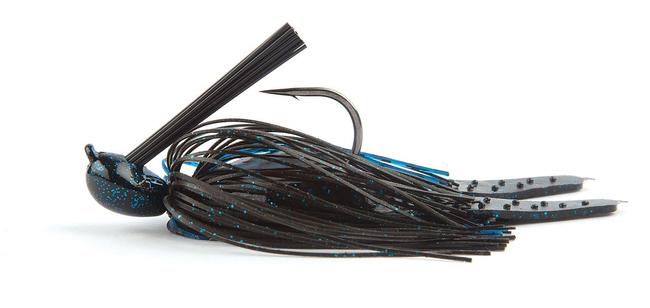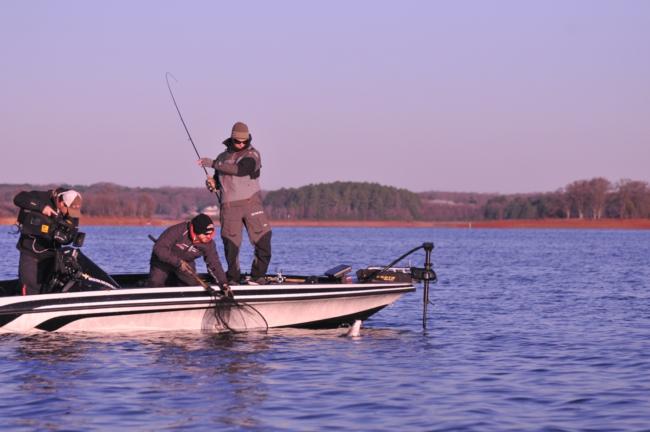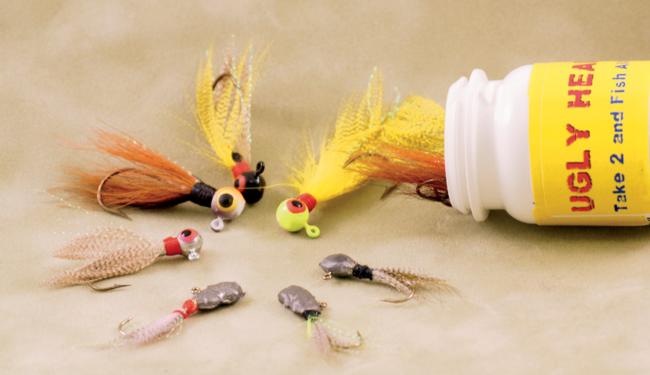Cold-Water Bass Fishing

Editor's note: These articles originally appeared in the January-February 2006 issue of FLW Bass Fishing Magazine, though the tips provided for wintertime bass fishing are as relevant today.
OK, so you don’t live in the Deep South, and winter has not released its grip on your neighborhood. The water is cold, and most of your friends are duck hunting. The thing is, you have the itch – the itch to do a little bass fishing.
Sounds good from home, but how do you get them to bite? After all, the water is cold, maybe 45 degrees or even lower, and they are not exactly on the feed. Still, you are not willing to wait for spring.
Well, there is no reason to wait. So long as the water is not frozen, you can catch a few. In fact, those few might be some of the bigger ones of the year.
To catch those winter bass you are dreaming about, you will need to approach your fishing from a different angle. You may have to look in some spots you have previously neglected, spend more time with your depth finder and fish a little slower, but it can be done.
Art Ferguson III of St. Clair Shores, Mich., is a successful professional angler. He has fished the Walmart Bass Fishing League, the Stren Series and the Walmart FLW Tour.
His approach is the same no matter if he is fishing a natural lake or a reservoir. Ferguson begins his winter largemouth search by analyzing the fall-feeding binge. He is looking for flats and other locations with deep water nearby. Experience has taught him that the fish will move off toward deeper water as fall turns into winter. Largemouths will not move any farther than they have to, however.
If they were on the top of a hump, he will look for them alongside of that same hump. If they were feeding up on a point, he will follow that same point out into where it drops off into a channel or a breakline.
 He points out, however, that they are not easy to find in cold water. Largemouths tend to “bunch up really tight” when it gets cold. Careful use of electronics is an absolute necessity, and thorough casting is not enough. It is too easy to miss the fish. They will not chase your lure, and you have to put it right on their nose. You cannot do that unless you know where they are.
He points out, however, that they are not easy to find in cold water. Largemouths tend to “bunch up really tight” when it gets cold. Careful use of electronics is an absolute necessity, and thorough casting is not enough. It is too easy to miss the fish. They will not chase your lure, and you have to put it right on their nose. You cannot do that unless you know where they are.
Once he finds them, it is time to go to work. Ferguson’s first choice of weapons is usually a jig-and-pig combination. Defying conventional wisdom, Ferguson fishes plastic, even in the coldest of waters.
On natural lakes, Ferguson reminds anglers not to overlook a possible shallow-water pattern. “If you can find some green weeds, even in cold water, fish them,” he said. He believes the oxygen from the greenery attracts the fish and increases their metabolism.
Good baits for green weeds include crankbaits and spinnerbaits. At times, a topwater plug will produce, especially when the air is heavy and there is a gentle snow falling.
His friend and fellow competitor, successful FLW Tour co-angler Troy Cox of Bono, Ark., agrees. Cox looks for his fish along breaks and channel swings in the general area of the fall feed. He reasons that once the water is below 50 degrees, the fall binge is over. The fish have moved into their winter homes.
Cox also emphasizes that careful use of electronics is a must. “They’re hard to find when it’s cold,” he said. “They bunch up really tight, but once you find them, you can catch them.”
Cox likes a small jig dressed with a grub or a tube. He casts it out, past the shallow fall-feeding area. After it settles to the bottom, he ever so gently drags it off the lip of the break and allows it to free-fall down into the depths.
If your lure stops falling too soon or if your line twitches, set the hook immediately. “Don’t give them any time to think about it – they’ll realize they aren’t that hungry and won’t bite it,” Cox said.
Bremen, Ind., pro Chip Harrison’s theories are similar in some respects but a bit different in others. His experiences fishing the BFL, Stren Series and the FLW Tour led him to believe that largemouth bass feed more in the winter than many anglers realize.
“A lot of anglers believe they stop feeding in cold water. Nothing could be further from the truth,” he said.
According to Harrison, anglers can find winter bass by finding the baitfish. He points out that baitfish move out over deeper water as it cools. He believes the bass follow the baitfish out and can usually be found in the same places.
Those are usually places not too far from the fall-feeding areas. He catches most of his winter bass below schools of baitfish holding off drops, channels, channel swings or over points that drop off into a deep channel or hole.
He cautions anglers, however, to go slowly in the winter. The fish are schooled up tightly, and it is easy to miss them. Harrison, like our other experts, advises anglers to keep an eye on their depth finder at all times.
 He likes to throw a blade bait when looking for fish. “It’s a great search tool. I can cover water quickly,” he said. When he finds a school, he continues to use the blade bait until the bass stop hitting it. After that, he switches to a small tube.
He likes to throw a blade bait when looking for fish. “It’s a great search tool. I can cover water quickly,” he said. When he finds a school, he continues to use the blade bait until the bass stop hitting it. After that, he switches to a small tube.
Interestingly, Harrison also commented on the shallow-water pattern in natural lakes. According to him, most anglers fish too deep on natural lakes in the winter. Most of his natural-lake largemouths come from water 8 to 12 feet deep around weeds or some sort of woody cover. Under those conditions, his lure recommendations include small crankbaits, small spinnerbaits or a jerkbait.
Smallmouths react very differently to cold water.
Dale Hollow smallmouth guide Bob Coan probably knows as much about coldwater smallmouths as anyone on the planet. In the deep, clear, canyon reservoirs he fishes, they can usually be found suspended at depths of 9 to 14 feet.
Typical wintering locations, at least when the water is below 55 degrees, is off bluffs. Smallmouths are choosy, however. Not just any bluff will do for them. They like those that drop out into the lake at a 45-degree angle. Most of those locations are at least 50 feet deep; some plunge to 70 or 80 feet.
Coan believes they are suspended above those depths because they are seeking the warmest water they can find while at the same time holding deep enough to feel safe.
The trick to catching them is to put something right on their nose. He uses the float ‘n’ fly technique. It is nothing fancy, just a small jig hung beneath a bobber. The depth of the jig can be regulated to hang a few inches above the smallmouths’ eyes. As it drifts by they bite it out of instinct.
If Coan’s theories are correct, his technique should work on just about any body of water. Anglers will need to adjust depths to their individual waters, but other than that, everything should be about the same.
There you have it. Our largemouth experts recommend careful use of electronics to find tightly bunched-up fish. Look in deeper water near fall-feeding areas. Throw jigs, jig-and-pig combinations, tubes and blade baits.
On natural lakes, try to find some green weeds, and do not fish too deep.
If smallies are your prey, look for them suspended over deep water.
Is your bass boat heated?
It’s not as silly as it sounds.
According to Dale Hollow smallmouth guide Bob Coan, a heater in your boat is an absolute necessity. “I couldn’t fish without it,” he said.
In one easy trip to your local Walmart, you can purchase what you need to install a portable, propane heater in your bass boat. Depending upon what model you purchase, it will cost between $50 and $100. Everything you need can be carried home in one bag.
Start with a catalytic propane heater. There are several models, and several offer automatic starters. With others, you will need a match or a lighter. On some, the heads angle out from the propane tank; on others, it points straight up in the air. Choose the options, features and designs that best suit your needs.
No matter the model you choose, however, it will run about eight hours on a small, standard-size propane tank. You can mount it in one of your cup holders or in one of your fishing-seat sockets.
If necessary, you can also easily build an adapter for your fishing-seat socket. Start with a large soup can. Remove the top. Drill a 3/4-inch hole through the bottom. Run a 3-inch-long, 3/4-inch diameter fully threaded bolt from inside the can out the bottom. Secure it to the can with a nut.
Slip the propane cylinder into the can. Slip the bolt into the socket. It might not be fancy, but it will be secure and safe. Do not use the braces or mounts that come with some of these units. They are not stable and are not safe for use with boats.
No matter which mounting system you use, make sure nothing is near the heater surface. It gets very hot and will damage fiberglass, burn carpet and could start a fire. That is the last thing you need on a bass boat carrying 40 gallons of fuel and floating on 45-degree water.
If you get cold, start the heater. Do not sell these small heaters short. As Coan says, “That little bit of heat means so much when there’s no other heat available. It changes your whole attitude – you fish better and have more fun.”
 The float ‘n’ fly’s lesser-known cousin
The float ‘n’ fly’s lesser-known cousin
By Jason Sealock
For smallmouth fishing in the brutal winter months, the float ‘n’ fly has not had many rivals in effectiveness. The technique, however, is not for everyone. It takes a painstaking approach to catch a quality stringer on the float ‘n’ fly in the dead of winter, sometimes requiring working one small spot all day for five to 10 bites.
Walmart Bass Fishing League angler Nathan Light of Kingsport, Tenn., and his regular fishing partner, Larry Fitzgerald of Jonesborough, Tenn., adopted a new approach to catching winter smallmouths on their home lakes of Cherokee and Holston because, as Light puts it, “I can’t stand throwing that float ‘n’ fly in one spot all day.” In fact, their approach has worked so well on their home waters they’ve expanded it to catch big smallmouths on Dale Hollow and even in Canada.
“We didn’t invent the technique, but I’d say we’ve perfected it over the past eight years,” Light said. It started when they asked a friend to pour some light jigs for them after getting beaten in a tournament by an angler fishing small jigs without a float. The first version of the jig was small – too small. His friend started widening his mold with a Dremel tool to meet Light’s specifications. The jigs were an immediate success, and Light and Fitzgerald decided that since they worked already, there was no need to smooth the mold out for production. They call their jigs “Ugly Heads” because of their brain-like shape from the rough cuts resulting from the Dremel tool. While Light didn’t see the bird it came from, he was told the dressing is duck feathers.
Their technique is simple. They tie their jigs, weighing slightly less than 1/8 ounce, to 4-pound line and use 7-foot custom mahogany, medium-light G. Loomis rods with a large-spooled spinning reel. They like to target points and bluffs with their technique, but they are most fond of 45-degree chunk-rock banks because they allow them to cover varying depths.
They cast the jigs to the shore and work them back to the boat, shaking the rod tip while letting the bait pendulum its way back to the boat. Many bites come directly below the boat. “The bite is the most unusual one you’ll ever experience, and the fight is the most exciting,” Light said. “You have to back reel because you just can’t count on your drag with fish this strong and line this light.
“It’s not a lure for fishing brush, either. If you throw it next to a piece of wood, you’ve just donated that jig.” But the jig doesn’t get hung up if fished correctly. The key is to keep the bait just off the bottom with a quivering motion as it pendulums back to the boat.
It’s not always a tournament-winning technique, but it has won Light and Fitzgerald quite a bit of money from December to April. Fifteen to 30 bass is not uncommon with this technique in a day of fishing, and Light has caught smallmouths weighing more than 5 pounds and limits of five smallmouths weighing more than 20 pounds. They only need a rod and a pill bottle of jigs to fish all day in the winter months.
“We always seem to get better gas mileage in the winter,” Light said. “Once we unload all our other rods, spinnerbaits and crankbaits, the boat rides a lot better and burns a lot less gas.”
For more information about their jigs and techniques, contact Nathan Light at [email protected].